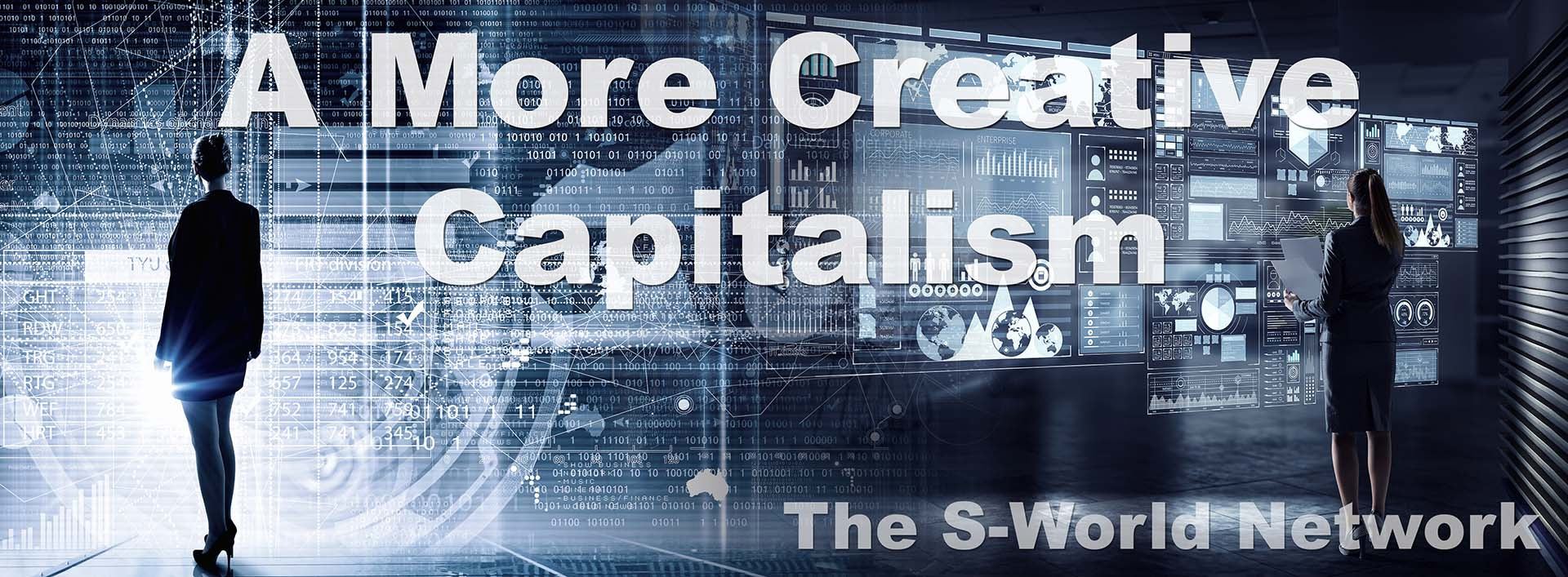A More Creative Capitalism
By Nick Ray Ball 1st November 2018

The book title is from Bill Gates’s 2007 Harvard commencement speech which helped inspired the S-World Network hypothesis and Angel Theory – Paradigm Shift, seen at www.AngelTheory.org.
Part 1. A Good Model – Points 1 and 2
Professors Hawking and Mlodinow’s prescription for ‘A Good Model’ starting with ingredients one and two: “Elegance and A Lack of Adjustable Parameters.”
Chapter 1. S-World Angelwing
Presents the four pillars of the Angelwing economic software before looking at the similarities between economics today and physics 60 years ago. Then, introduces M-theory care of Hawking and Mlodinow, and suggests that economics needs a similar framework today, and cites work from Krugman and Rodrik to help illustrate the point; before concluding with the oldest element of financial engineering from 2011 care of chaos theory – POP – The Point of Profitability, also known as the Financial Gravity, a fundamental law in the S-World Network hypothesis.
Chapter 2. String Theory Systems
Uncovers more financial engineering and simple laws such as the Peet Tent, the Susskind Boost, the Green Symmetry, and the less simple Super Coupling; analogised from the physics discipline string theory, the forerunner to M-theory, and cites work from A.W. Peet, Leonard Susskind, Michael Green, Brian Greene, and Edward Witten. The principle lesson in this chapter is that in simulations and analogies, from physics to economics, the equivalent to a string is money.
Chapter 3. A Quantum Theory of Economics
Pits the previous two chapters against each other, amidst quotes and inspirations from Rodrik, Krugman, Amelino-Camelia, Witten, Thaler, Musk, and Stiglitz; and concludes with the simple idea that if you can direct how most money is spent, then you have a quantum theory of economics, which as we see in the ŔÉŚ Equation is powerful. The craft then becomes how to create such an environment while still making everyone happy and allowing free will.
Chapter 4. The ŔÉŚ Equation
This is the chapter that accompanied this letter. It is my burning question, it’s just that it can’t be that easy, can it? If correct, then it’s a paradigm shift in economics. But let’s wait to hear what the experts say. If it’s correct, awesome. If not, there are other methods of increasing the money supply within the environment presented.
Chapter 5. Total Business Systems – The TBS™ & S-Web™ (Super Project 1)
The first of the four super projects from ‘Angel Theory – Paradigm Shift – Volume 1,’ partly described in Network.villasecrets.com. This is the business networking software that inspired the first network description in 2011, it seeks to gather data and learn. In virtual networks, it creates AIs and guides its users, or in Grand Networks or (as Paul Romer presents) Charter Cities, it gives options to users, but ultimately only options close to what an econ would choose.
Part 2. A Good Model – Point 3:
“Agrees with and Explains all Existing Observations”
Chapter 6. Charter Cities – Starter Cities – Super Massive Networks
https://paulromer.net/interview-on-urbanization-charter-cities-and-growth-threory
Charter Cities have been central to the S-World Network since 2011. There have been 4 designs:
New Sparta City of Science, the Orlando Network, MARS Resort 1, and the Malawi Network.
Chapter 7. S-World Films and BES™ – Behavioural Economic Systems (Super Project 3)
S-World Films is PR and Marketing which shares in the super project’s income. There are hundreds of BES™ Systems, two of my favourites are the UCS™ Observer and the Malawi Soccer League.
Chapter 8. S-World VSN™ – Virtual Social Network (Super Project 2)
Just too big to summarise, for Mark Zuckerberg, Elon Musk, Sergey Brin et al.
Chapter 9. Power, Virtual Education, and the Learning Society
To create a learning society that learns via virtual technology, you first need electricity.
Chapter 10. Ecological Rules – EEE The Ecological Experience Economy
Many, but my favourite is Sienna’s Forests where each km2 developed must be half nature.
Chapter 11. Dynamic Comparative Advantage, Heterogeneity, and Aid.
Discusses and elaborates on trade and aid factors mentioned in the ŔÉŚ Equation chapter.
Chapter 12. The Virtual Network | Microeconomics
The Virtual Network is any business not in a Charter City. For example, www.VillaSecrets.com in thousands of locations. Lays the foundations for the trade hubs mentioned in the ŔÉŚ Equation.
Part 3. A Good Model – Point 4: “Makes detailed predictions about future observations that can disprove or falsify the model if they are not borne out.”
Chapter 14. S-World UCS™ – Universal Colonization Simulator (Super Project 4)
The mother of all MMO games; trains, teaches, recruits, and simulates everything.
Chapter 15. Elephants and Externalities
So far, 26 different social, philanthropic, ecological or science projects created as externalities.
Chapter 16. Equality
How the network is structured to elevate future equality traps, as described by Thomas Piketty.
Chapter 17. UCS™ Voyagers and the Feynman Sum Over Histories
Concluding Hawking and Mlodinow’s ‘A Good Model’ with Feynman’s Sum Over Histories.
Chapter 18. Angel City 5 – Earth 2080 and the Co-Founders
The S-World Network hypothesis ends at 5 simulated futures known as Angel Cities in 2020, 2024, 2032, 2048 and 2080. We must imagine, then simulate, then try like hell to apply.
This chapter tells of the first desired co-founders and their potential place in the Angel Cities.










